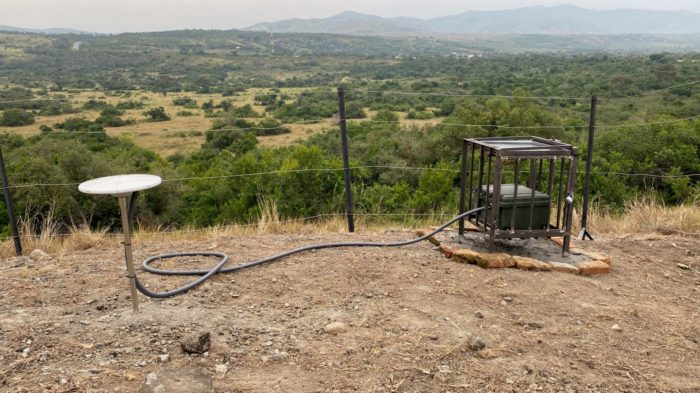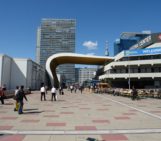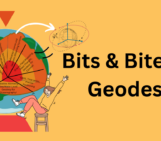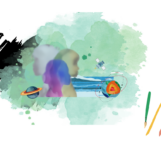
Africa hosts the world’s most extensive subaerial rift system on Earth known as the East African Rift System (EARS). It stretches over 5000 km from the Red Sea and Gulf of Aden intersection in the north to the Southwest Indian Spreading Ridge south of South Africa. East-West, the EARS spans the eastern border of the Democratic Republic of Congo across to eastern Madagascar over 3000 km. The process of continental rifting involves rupturing the entire thickness of the lithosphere, and has been studied for decades. Millimeter precision constraints on exactly how fast the lithosphere is moving and how that movement is distributed spatially requires Global Navigation Satellite System (GNSS) observations. Two kinds of GNSS observations are used to study tectonic processes like continental rifting: continuous GNSS and episodic (aka. campaign) GNSS. Continuous GNSS observations are semi-permanent or permanent installations, ideally in bedrock, that continuously collect data for a minimum of 2.5 years to get tectonic velocities. Episodic GNSS observations are repeated measurements of the same metallic fixed benchmark, also ideally installed in bedrock, over at least 3-5 years.

Photo 1: D. Sarah Stamps and Elifuraha Saria in Tanzania conducting episodic GNSS observations in 2006. Photo Credit: Eric Calais.
I have been collecting both continuous and episodic GNSS observations in Africa for more than 15 years in the countries of Madagascar, Tanzania, Kenya, and Uganda to improve our understanding of how continents break apart. My first experience collecting GNSS data in Africa was through a US National Science Foundation Undergraduate Research Experience in Tanzania as part of Professor Eric Calais’ team while I was earning my Bachelor of Science degree in Earth Sciences at The University of Memphis in Tennessee, USA (Photo 1). That project involved installing and measuring new geodetic benchmarks for episodic observations and measuring existing benchmarks with high precision dual-frequency GNSS equipment. Since that experience in Tanzania in 2006 was successful, I was assigned to a German RiftLink project led by Professor Daniel Koehn to observe the Rwenzori Mountains in Uganda in 2007, 2008, 2009, and 2012 (Photo 2). As a PhD student, I also wrote several proposals to install and measure a network of geodetic benchmarks across Madagascar to test if the island itself was breaking up. Since those early years working in Africa as a student, I have had the honor of getting several NSF projects funded to work in Tanzania, Uganda, Kenya, and Madagascar, which involves training African students in the fields of geodesy and geodynamics. Currently, I am training a PhD student from Tanzania at Virginia Tech (Mr. Ntambila Simon “Daud” Masungulwa), an MS student at the University of Nairobi, Kenya (Ms. Jane Wambui), and a PhD student from Uganda at Virginia Tech (Ms. Asenath Kwagalakwe). I also graduated a PhD student from Madagascar (Mr. Tahiry Rajaonarison) in 2020 who is working at the University of Antananarivo in Madagascar and starting a postdoc at New Mexico Tech. Currently I have installed 19 open-access continuous GNSS stations that are operating in East Africa at this time, of which 4 were installed in Uganda in January 2022 in collaboration with the Uganda Ministry of Energy and Mineral Development.

Photo 2: Episodic GNSS station in the Rwenzori Mountains of Uganda in 2008 with a tropical glacier and three team members in the background. Photo Credit: D. Sarah Stamps.
It has been a wonderful experience working in Africa collecting GNSS data. The landscape is beautiful, the people are welcoming and kind, and the work is unbelievably interesting. Occasionally we have interactions with wild animals. For example, while checking out a Serengeti research house, a baboon followed me into the house. He was at least 4 feet tall and very intimidating. I tried to scare him out of the house, but he only flinched. Then I grabbed a broom and ran at him, chasing him out of the house. It turns out the baboon was distracting us while his gang of monkeys and baboons ransacked our car for all the food! More fun field stories can be found in the National Geographic Kids book where I’m featured in the so-called “Absolute Expert: Rocks and Minerals” (link). Also, a recent manuscript that I led came out in Geology that was a culmination of my African data collection efforts over the years called “Redefining East African Rift System Kinematics” (link). I provided all of the model input and output files, as well as all of the data so anyone can reproduce the work in the FigShare repository (link). I hope you will check out the new kinematic model!




